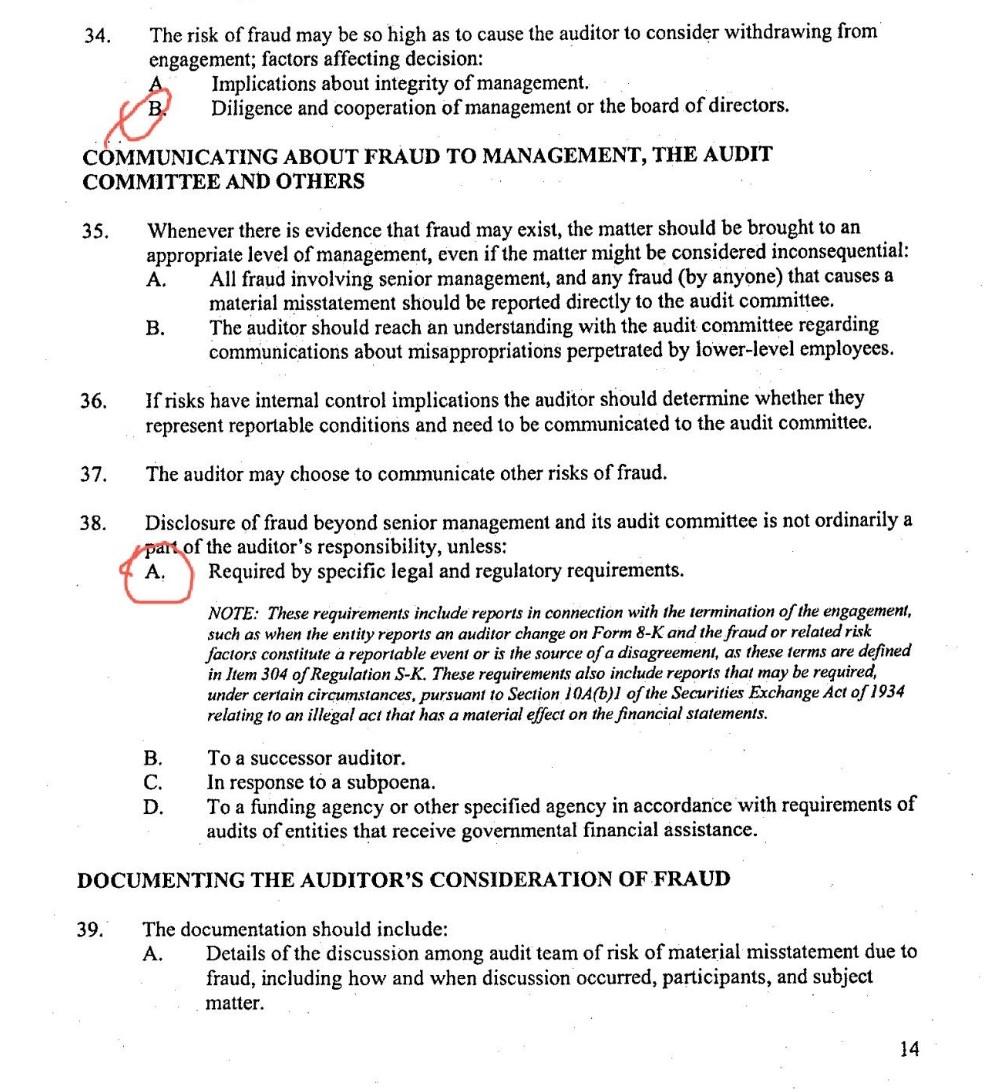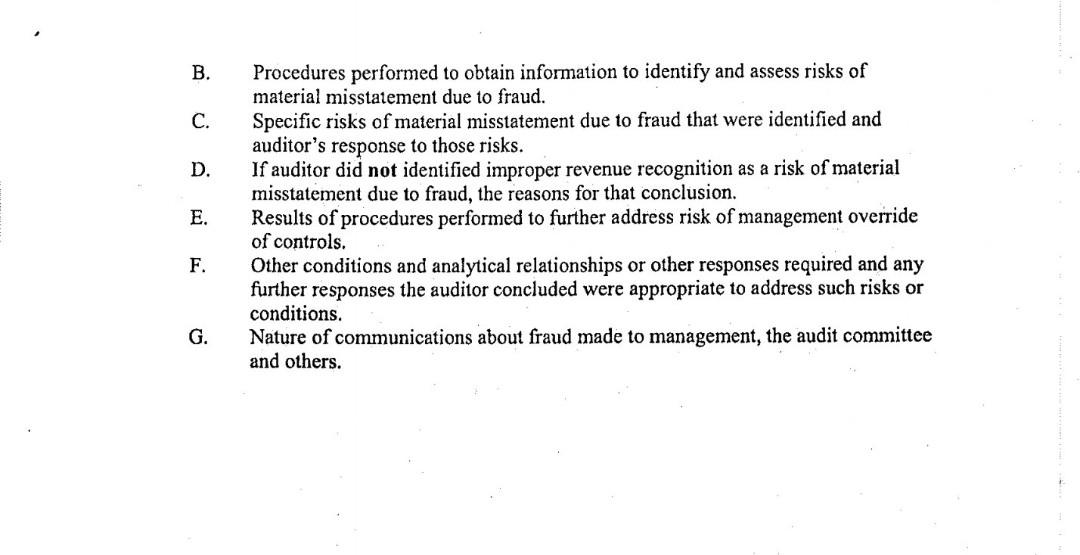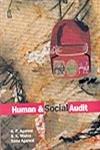Answered step by step
Verified Expert Solution
Question
1 Approved Answer
p14-15 34. The risk of fraud may be so high as to cause the auditor to consider withdrawing from engagement; factors affecting decision: A Implications


p14-15
34. The risk of fraud may be so high as to cause the auditor to consider withdrawing from engagement; factors affecting decision: A Implications about integrity of management. B. Diligence and cooperation of management or the board of directors. COMMUNICATING ABOUT FRAUD TO MANAGEMENT, THE AUDIT COMMITTEE AND OTHERS 35. Whenever there is evidence that fraud may exist, the matter should be brought to an appropriate level of management, even if the matter might be considered inconsequential: A. All fraud involving senior management, and any fraud (by anyone) that causes a material misstatement should be reported directly to the audit committee. B. The auditor should reach an understanding with the audit committee regarding communications about misappropriations perpetrated by lower-level employees. 36. If risks have internal control implications the auditor should determine whether they represent reportable conditions and need to be communicated to the audit committee. 37. The auditor may choose to communicate other risks of fraud. 38. Disclosure of fraud beyond senior management and its audit committee is not ordinarily a part of the auditor's responsibility, unless: A. Required by specific legal and regulatory requirements. NOTE: These requirements include reports in connection with the termination of the engagement, such as when the entity reports an auditor change on Form 8K and the fraud or related risk factors constitute a reportable event or is the source of a disagreement, as these terms are defined in Item 304 of Regulation S - K. These reguirements also include reports that may be required, under certain circumstances, pursuant to Section 10A(b)1 of the Securities Exchange Act of 1934 relating to an illegal act that has a material effect on the financial statements. B. To a successor auditor. C. In response to a subpoena. D. To a funding agency or other specified agency in accordance with requirements of audits of entities that receive governmental financial assistance. DOCUMENTING THE AUDITOR'S CONSIDERATION OF FRAUD 39. The documentation should include: A. Details of the discussion among audit team of risk of material misstatement due to fraud, including how and when discussion occurred, participants, and subject matter. 14 B. Procedures performed to obtain information to identify and assess risks of material misstatement due to fraud. C. Specific risks of material misstatement due to fraud that were identified and auditor's response to those risks. D. If auditor did not identified improper revenue recognition as a risk of material misstatement due to fraud, the reasons for that conclusion. E. Results of procedures performed to further address risk of management override of controls. F. Other conditions and analytical relationships or other responses required and any further responses the auditor concluded were appropriate to address such risks or conditions. G. Nature of communications about fraud made to management, the audit committee and others. 34. The risk of fraud may be so high as to cause the auditor to consider withdrawing from engagement; factors affecting decision: A Implications about integrity of management. B. Diligence and cooperation of management or the board of directors. COMMUNICATING ABOUT FRAUD TO MANAGEMENT, THE AUDIT COMMITTEE AND OTHERS 35. Whenever there is evidence that fraud may exist, the matter should be brought to an appropriate level of management, even if the matter might be considered inconsequential: A. All fraud involving senior management, and any fraud (by anyone) that causes a material misstatement should be reported directly to the audit committee. B. The auditor should reach an understanding with the audit committee regarding communications about misappropriations perpetrated by lower-level employees. 36. If risks have internal control implications the auditor should determine whether they represent reportable conditions and need to be communicated to the audit committee. 37. The auditor may choose to communicate other risks of fraud. 38. Disclosure of fraud beyond senior management and its audit committee is not ordinarily a part of the auditor's responsibility, unless: A. Required by specific legal and regulatory requirements. NOTE: These requirements include reports in connection with the termination of the engagement, such as when the entity reports an auditor change on Form 8K and the fraud or related risk factors constitute a reportable event or is the source of a disagreement, as these terms are defined in Item 304 of Regulation S - K. These reguirements also include reports that may be required, under certain circumstances, pursuant to Section 10A(b)1 of the Securities Exchange Act of 1934 relating to an illegal act that has a material effect on the financial statements. B. To a successor auditor. C. In response to a subpoena. D. To a funding agency or other specified agency in accordance with requirements of audits of entities that receive governmental financial assistance. DOCUMENTING THE AUDITOR'S CONSIDERATION OF FRAUD 39. The documentation should include: A. Details of the discussion among audit team of risk of material misstatement due to fraud, including how and when discussion occurred, participants, and subject matter. 14 B. Procedures performed to obtain information to identify and assess risks of material misstatement due to fraud. C. Specific risks of material misstatement due to fraud that were identified and auditor's response to those risks. D. If auditor did not identified improper revenue recognition as a risk of material misstatement due to fraud, the reasons for that conclusion. E. Results of procedures performed to further address risk of management override of controls. F. Other conditions and analytical relationships or other responses required and any further responses the auditor concluded were appropriate to address such risks or conditions. G. Nature of communications about fraud made to management, the audit committee and othersStep by Step Solution
There are 3 Steps involved in it
Step: 1

Get Instant Access to Expert-Tailored Solutions
See step-by-step solutions with expert insights and AI powered tools for academic success
Step: 2

Step: 3

Ace Your Homework with AI
Get the answers you need in no time with our AI-driven, step-by-step assistance
Get Started


